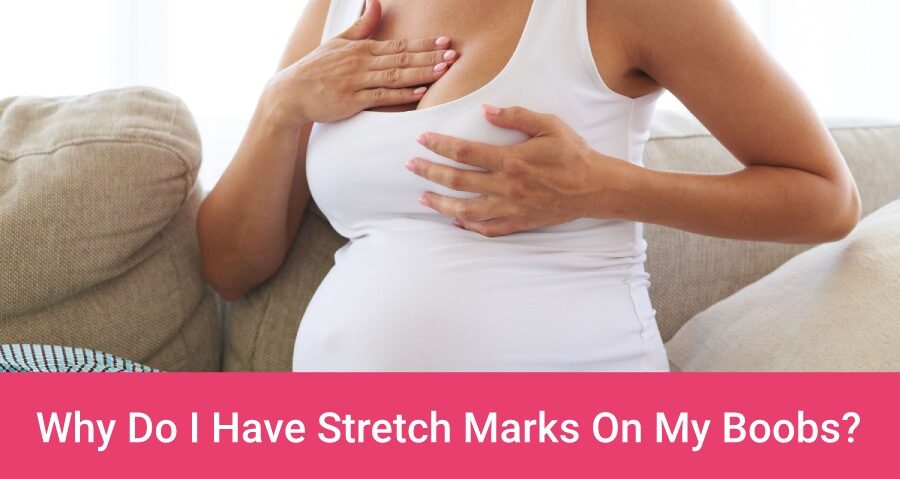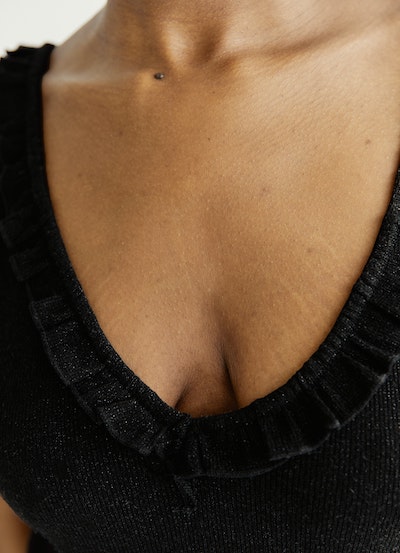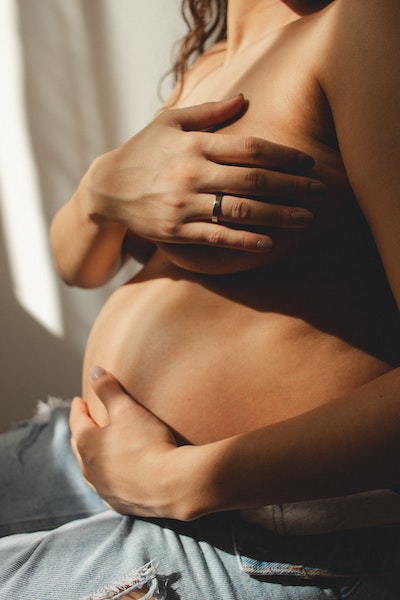
Article by Macy Tollefson – doula, breastfeeding specialist & prenatal yoga teacher
It’s pretty common for women to be aware of the risk of developing stretch marks on belly during pregnancy, but did you know that stretch marks on breasts are common as well?
In this article, you’ll learn everything you need to know about stretch marks on breasts during pregnancy, including why it happens, if it’s dangerous, and effective tips for preventing and treating them.
This article is not a substitute for medical advice.
Is It Normal To Get Stretch Marks On Your Breasts When Pregnant?
Around 90%1 of women will experience stretch marks during pregnancy (called striae gravidarum), and although they are NOT dangerous, they can be jarring to see on your body.
The average woman goes up a bra cup size (or two!) as breast tissue increases during pregnancy. That rapid growth will stretch the skin, increasing your chances of getting stretch marks on breasts.
While experts2 say that stretch marks are a common outcome of skin stretching during pregnancy, it is also a normal reaction to want to reduce their visibility of them on your body.
Do All Women Develop Stretch Marks On Breasts?
Although it is extremely common, not all women will develop stretch marks on their breasts.
Perhaps you developed stretch marks during puberty (like many girls do) when their breasts begin to grow, but it is possible to experience breast growth and not see stretch marks. Every person’s body is different!
There are a few factors that may impact whether or not you experience stretch marks. Family history, for example, plays a big role, as your collagen production is directly related to your genes3. You may want to check with your mom or sisters if they had developed stretch marks on breasts when pregnant.
Other factors include your lifestyle (ex. if you have a healthy diet or get regular exercise), weight gain amount (and how quickly you gained it), your skin elasticity, and your skin health.
Certain health conditions (such as Cushing’s Syndrome), medical treatments (such as breast augmentation) or even hormonal birth control pills may also make you more susceptible to developing stretch marks on your breasts.

Why Am I Developing Stretch Marks On Breast During Pregnancy?
From the moment you conceive, your hormones begin to change, and one of the first places you may notice these changes, is in your breast tissue.
Breasts start to grow in size towards the end of the first trimester, as they begin to prepare for milk production. Thanks to all of these hormonal changes, your breast size can grow RAPIDLY during pregnancy, which makes it difficult for the elasticity and collagen production in your skin to keep up.
Your breast tissue multiplies from the increased blood flow and milk ducts enlarging, causing the skin on your breast to stretch. As the skin stretches, the breast tissue loses elasticity and stretch marks may occur as a result.
These little red lines are essentially scars of the skin tissue, caused by the stretching from this rapid growth.
Your genetics and family history are a big determinant of whether or not you will experience stretch marks, as well as your overall lifestyle. There is little evidence4 to show that topical remedies (such as bitter almond oil or hyaluronic acid) can prevent stretch marks or reduce the severity of them. If you end up getting stretch marks, it doesn’t mean you did something “wrong”.
Developing breast stretch marks may seem alarming at first, but it is completely normal and especially common for pregnant women.
Does Breastfeeding Give You Stretch Marks?
Regardless of if you choose to breastfeed or not, your body will do its best to prepare for lactation throughout your pregnancy. On top of your breasts growing due to the increased blood flow of pregnancy, your milk ducts and breast tissues are also hard at work, getting ready to feed your baby.
The combination of these things may cause stretch marks on breasts, as they enlarge – even if you do not end up breastfeeding after birth.
If you do choose to breastfeed, your breast tissue may continue to expand rapidly as your body produces milk. Because of this, your skin could remain stretched for longer periods of time (as opposed to pregnancy alone), which may or may not increase your chances of getting stretch marks on your breasts. Again – everyone is different!
Once your breastfeeding journey is complete, you may also notice stretch marks appear as your breast size shrinks back down, as sudden weight loss can also cause them.
Are Breast Stretch Marks Dangerous For New Mom Or Baby?
The short answer is, NO.
Stretch marks themselves are completely harmless and don’t cause pain. Stretch marks occur in the connective tissues of the dermis (right below the top layer of skin), and impose NO risk factors to the rest of the body.
While they may be anxiety-provoking to see on your body, you can rest assured that not only are they harmless, they are completely normal.

What Do Pregnancy Breast Stretch Marks Look Like?
Stretch marks look different on everybody (especially light and dark skin), but they tend to be red, purple, pink, dark brown or silver in color. They look like narrow bands that appear over top of the area of skin that was stretched.
Early stretch marks on the breast may be slightly raised on the skin, and feel itchy5. Some are barely noticeable, while others are darker in color or appear wider in shape. Over time, they will fade to a paler color and may look more wrinkly.
Stretch marks on breasts look different on everyone, and are really dependent on your individual hormone levels, the intensity of the skin stretching, and how long the skin remains stretched.
How To Prevent Stretch Marks On Breast During Pregnancy?
While it may not be possible to completely avoid stretch marks, there are some ways to help reduce them, or make them less noticeable.
Because the biggest risk factor of experiencing stretch marks is rapid weight gain, try to maintain a healthy weight throughout your pregnancy. Gaining weight SLOWLY and staying within your doctor’s recommended weight gain amount can help.
Start moisturizing your breasts early on in your pregnancy, massaging oil or lotion onto the skin on your breast daily. If your skin is moisturized and supple, this may help REDUCE stretch marks, as your skin is able to stretch further without damage.
| PRO TIP: Focus on adding moisturizes into your daily routine that will help you improve skin ELASTICITY. Belly oil for stretch marks may help to prevent them – here you can find my ranking of the best ones. And they can be used on other parts of your body that are prone to striae gravidarum too. |
A 2013 study6 found that a combination of hydroxyprolisilane C, rosehip oil, Centella asiatica extract, and vitamin E reduced the risk of stretch marks on breasts during pregnancy, and even HALTED the expansion of stretch marks already present on the breasts (yes, rosehip oil is safe during pregnancy, even though it contains vitamin A!).
While research may be divided7 on the effectiveness of topical treatments for everyone, a daily breast massage DOES help promote blood circulation and collagen production8. Just make sure to use a pregnancy-safe moisturizer, such as almond oil, cocoa butter or olive oil (here you can read more about ingredients that are safe for pregnant women).
Exfoliation is another great way to stimulate collagen production in your breasts and PREVENT stretch marks. Do it once a week, moving in a circular motion with an organic exfoliator, and be sure to moisturize after.
Get regular exercise, and focus on stretching exercises, such as yoga or aerobics, that slowly stretch the skin. Doing exercises that work the chest and back muscles may also help the skin of the breasts as well.
And finally, stay HYDRATED! When our body has proper hydration, our skin can maintain its elasticity much better. Further, hydrated skin can actually prevent scars9 (which is essentially what stretch marks are) and help existing ones fade faster.
Do Pregnancy Stretch Marks On Boobs Go Away?
Just like any scar, stretch marks are permanent, but studies10 show that they will fade over time. For example, even if they don’t disappear completely, red stretch marks on breasts, may eventually fade to a light pink or a less noticeable, silver color.
How To Treat Stretch Marks On Boobs After Pregnancy?
Many women choose to see their stretch marks as a badge of honour and a symbol for the amazing work their body has just done – but it’s okay if you want them gone too! There are many treatments available to help lighten stretch marks on your breasts.
Keeping the skin of your breast moisturized as the skin shrinks back down (after pregnancy or breastfeeding) may help the scars fade quicker. Regular exfoliation will also help remove those dead skin cells, making room for newer, healthier skin tissue.
While there is no guaranteed way of removing them all together11, some medical treatments may help reduce the appearance of stretch marks. Keep in mind, if you are still pregnant or breastfeeding, your doctor or dermatologist may not recommend certain treatments (such as tretinoin) or procedures.
Your healthcare provider may start with topical treatments, before moving up to a more advanced intervention, such as laser therapy, cosmetic surgery, or microdermabrasion. They may need to do a combination of procedures, to get the best results.
Some of these procedures may include:
- Light or laser therapy to help break down scar tissue, and make room for new, healthy tissue growth. Laser therapy helps to stimulate damaged tissues to repair.
- Microdermabrasion and microneedling treatment to help stimulate the production of collagen and elastin under the skin12.
- Cosmetic surgery or other medical treatment procedures may also help.
Experts say13 the earlier you see a dermatologist, the easier it may be to treat stretch marks. So if you are concerned about the stretch marks on your breasts, be sure to consult your health care provider as soon as possible.
Article By Macy Tollefson
Macy Tollefson is a full spectrum doula, breastfeeding specialist and prenatal yoga teacher. She is passionate about guiding the modern mama on her journey through the beautiful (and wild) transformation of pregnancy, birth and postpartum. Macy envisions a world where every mother has access to the resources she needs, and follows her intuition to make the best decisions about what is right for her and her baby.
The purpose of this article is informative. It’s not a substitute for professional medical advice or medical care. Remember: safety first! Consult your doctor/pediatrician in case of any doubts. The author of this article does not accept any responsibility for any liability, loss or risk, personal or otherwise, incurred as a consequence, directly or indirectly, from any information or advice contained here.

